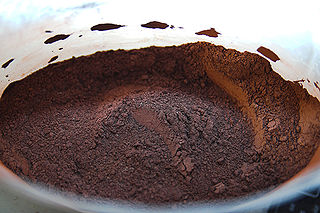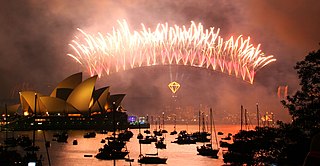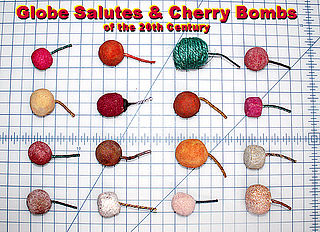
Thermite is a pyrotechnic composition of metal powder and metal oxide. When ignited by heat or chemical reaction, thermite undergoes an exothermic reduction-oxidation (redox) reaction. Most varieties are not explosive, but can create brief bursts of heat and high temperature in a small area. Its form of action is similar to that of other fuel-oxidizer mixtures, such as black powder.

Fireworks are a class of low explosive pyrotechnic devices used for aesthetic and entertainment purposes. They are most commonly used in fireworks displays, combining a large number of devices in an outdoor setting. Such displays are the focal point of many cultural and religious celebrations, though mismanagement could lead to fireworks accidents.

A match is a tool for starting a fire. Typically, matches are made of small wooden sticks or stiff paper. One end is coated with a material that can be ignited by friction generated by striking the match against a suitable surface. Wooden matches are packaged in matchboxes, and paper matches are partially cut into rows and stapled into matchbooks. The coated end of a match, known as the match "head", consists of a bead of active ingredients and binder, often colored for easier inspection. There are two main types of matches: safety matches, which can be struck only against a specially prepared surface, and strike-anywhere matches, for which any suitably frictional surface can be used.

Pyrotechnics is the science and craft of creating such things as fireworks, safety matches, oxygen candles, explosive bolts and other fasteners, parts of automotive airbags, as well as gas-pressure blasting in mining, quarrying, and demolition. This trade relies upon self-contained and self-sustained exothermic chemical reactions to make heat, light, gas, smoke and/or sound. The name comes from the Greek words pyr ("fire") and tekhnikos.

A skyrocket is a type of firework that uses a solid-fuel rocket to rise quickly into the sky; a bottle rocket is a small skyrocket. At the apex of its ascent, it is usual for a variety of effects to be emitted. Skyrockets use various stabilisation techniques to ensure the flight follows a predictable course, often a long stick attached to the side of the motor, but also including spin-stabilisation or fins.

A Roman candle is a traditional type of firework that ejects one or more stars or exploding shells. Roman candles come in a variety of sizes, from 6 mm (0.24 in) diameter for consumers, up to 8 cm (3.1 in) diameter in professional fireworks displays.

In an explosive, pyrotechnic device, or military munition, a fuse is the part of the device that initiates function. In common usage, the word fuse is used indiscriminately. However, when being specific, the term fuse describes a simple pyrotechnic initiating device, like the cord on a firecracker whereas the term fuze is used when referring to a more sophisticated ignition device incorporating mechanical and/or electronic components, such as a proximity fuze for an M107 artillery shell, magnetic or acoustic fuze on a sea mine, spring-loaded grenade fuze, pencil detonator, or anti-handling device.

Pyrotechnic stars are pellets of pyrotechnic composition which may contain metal powders, salts or other compounds that, when ignited, burn a certain color or make a certain spark effect. They are a part of all projectile-type fireworks. The most common is the aerial shell. When watching this firework, it will launch into the sky, burning a lifting charge. Once the shell has attained proper altitude, due to other mechanisms within the firework, it will ignite the stars.

Slow match, also called match cord, is the slow-burning cord or twine fuse used by early gunpowder musketeers, artillerymen, and soldiers to ignite matchlock muskets, cannons, shells, and petards. Slow matches were most suitable for use around black-powder weapons because a slow match could be roughly handled without going out, and only presented a small glowing tip instead of a large flame that risked igniting nearby gunpowder. Slow match of various types was one of the first kinds of artillery fuse.
In pyrotechnics a salute is a device primarily designed to make a loud report (bang), rather than have a visual effect, although most salutes also have a bright flash. They most commonly consist of a 70:30 mixture of potassium perchlorate and dark aluminium powder and may have titanium added for a cloud of sparks. The salute may be fired on the ground or launched from a mortar as a shell. Due to the nature of the effect, large salutes are some of the more hazardous fireworks.
In pyrotechnics, black match is a type of crude fuse, constructed of cotton string fibers intimately coated with a dried black powder slurry.

A cherry bomb is an approximately spherical exploding firework, roughly resembling a cherry in size and shape. Cherry bombs range in size from three-quarters to one and a half inches in diameter.
A pyrotechnic colorant is a chemical compound which causes a flame to burn with a particular color. These are used to create the colors in pyrotechnic compositions like fireworks and colored fires. The color-producing species are usually created from other chemicals during the reaction. Metal salts are commonly used; elemental metals are used rarely.
A pyrotechnic composition is a substance or mixture of substances designed to produce an effect by heat, light, sound, gas/smoke or a combination of these, as a result of non-detonative self-sustaining exothermic chemical reactions. Pyrotechnic substances do not rely on oxygen from external sources to sustain the reaction.
A plastic igniter cord (PIC) is a type of fuse used to initiate an explosive device or charge. In appearance igniter cord is similar to safety fuse and when ignited, an intense flame spits perpendicular to the cord at a uniform rate as it burns along its length. Igniter cord in the construction and demolition industry is similar to a safety fuse, consisting of a pyrotechnic composition at the core, wrapped with a nylon sheath to provide shape and finally wrapped again in an outer plastic shell to provide water resistance. Normally, igniter cord also consists of a metal wire at the very center of the pyrotechnic core which also runs the entire length of the cord; the pyrotechnic composition will react with the metal wire to increase the energetics of the fuse. There are two types of PICs: the fast type which has nominal burning speed of 30 cm per second, a diameter of about 3 mm, and is brownish in color; and the slow type, which has a diameter of 2 mm, is greenish in color, and has a nominal burning speed of 3 cm per second.
Ejection charge, also called expelling charge, is a pyrotechnic composition, a type of a pyrotechnic gas generator designed to produce a small short-term amount of thrust to burst open a container and eject its content.
The safety fuse is a type of fuse invented and patented by English inventor William Bickford in 1831. Originally it consisted of a "tube" of gunpowder surrounded by a waterproofed varnished jute "rope." It replaced earlier and less reliable methods of igniting gunpowder blasting charges which had caused many injuries and deaths in the mining industry. The safety fuse burns at a rate of typically about 30 seconds per foot.
Thermalite is a specific type of fuse used in pyrotechnic applications. The product was designed to be used in cross matching safety fuses of the Bickford type. As safety fuse is designed to neither give nor take fire through the heavy fuse jacket, ignition may be achieved by punching a hole perpendicular to and through a safety fuse powder core, threading a piece of Thermalite or similar igniter cord through the hole, then gently squeezing the safety fuse with pliers or similar to bring the powder core into contact with the igniter cord. The Thermalite could be ignited by a match, or more certainly by a purpose made igniter, similar to a wire sparkler.

A spark is an incandescent particle. Sparks may be produced by pyrotechnics, by metalworking or as a by-product of fires, especially when burning wood.

This is an alphabetized glossary of terms pertaining to lighting fires, along with their definitions. Firelighting is the process of starting a fire artificially. Fire was an essential tool in early human cultural development. The ignition of any fire, whether natural or artificial, requires completing the fire triangle, usually by initiating the combustion of a suitably flammable material.












